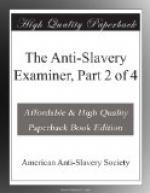[Footnote A: We have the following testimony of Sir Lionel Smith to the superiority of St. Thomas in the East. It is taken from the Royal Gazette, (Kingston.) May 6, 1837. “His Excellency has said, that in all his tour he was not more highly gratified with any parish than he was with St. Thomas in the East.”]
We called on the Wesleyan missionary at Morant Bay, Rev. Mr. Crookes, who has been in Jamaica fifteen years. Mr. C. said, that in many respects there had been a great improvement since the abolition of slavery, but, said he, “I abominate the apprenticeship system. At best, it is only improved slavery.” The obstacles to religious efforts have been considerably diminished, but the masters were not to be thanked for this; it was owing chiefly to the protection of British law. The apprenticeship, Mr. C. thought, could not be any material preparation for freedom. He was persuaded that it would have been far better policy to have granted entire emancipation at once.
In company with Mr. Howell, an Independent, and teacher of a school of eighty negro children in Morant Bay, we drove out to Belvidere estate, which is situated about four miles from the bay, in a rich district called the Blue Mountain Valley. The Belvidere is one of the finest estates in the valley. It contains two thousand acres, only four hundred of which are cultivated in sugar; the most of it is woodland. This estate belongs to Count Freeman, an absentee proprietor. We took breakfast with the overseer, or manager, Mr. Briant. Mr. B. stated that there was not so much work done now as there was during slavery. Thinks there is as much done for the length of time that the apprentices are at work; but a day and a half every week is lost; neither are they called out as early in the morning, nor do they work as late at night. The apprentices work at night very cheerfully for money: but they will not work on Saturday for the common wages—quarter of a dollar. On inquiry of Mr. B. we ascertained that the reason the apprentices did not work on Saturdays was, that they could make twice or three times as much by cultivating their provision grounds, and carrying their produce to market. At night they cannot cultivate their grounds, then they work for their masters “very cheerfully.”
The manager stated, that there had been no disturbance with the people of Belvidere since the change. They work well, and conduct themselves peaceably; and he had no fear but that the great body of the negroes would remain on the estate after 1840, and labor as usual. This he thought would be the case on every estate where there is mild management. Some, indeed, might leave even such estates to try their fortunes elsewhere, but they would soon discover that they could get no better treatment abroad, and they would then return to their old homes.




